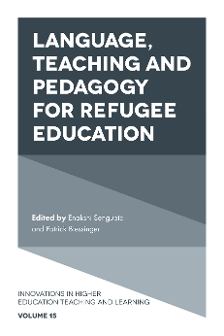
Subject Index
Language, Teaching, and Pedagogy for Refugee Education
ISBN: 978-1-78714-800-0, eISBN: 978-1-78714-799-7
ISSN: 2055-3641
Publication date: 2 January 2019
Citation
(2019), "Subject Index", Sengupta, E. and Blessinger, P. (Ed.) Language, Teaching, and Pedagogy for Refugee Education (Innovations in Higher Education Teaching and Learning, Vol. 15), Emerald Publishing Limited, Leeds, pp. 209-219. https://doi.org/10.1108/S2055-364120180000015019
Publisher
:Emerald Publishing Limited
Copyright © 2019 Emerald Publishing Limited
INDEX
Note: Page numbers followed by “n” with numbers indicate notes.
- Prelims
- Part I Seeking Higher Education
- Introduction to Language, Teaching, and Pedagogy for Refugee Education
- Chapter 1 Asylum-Seeking Students’ Experience of Higher Education in the UK
- Chapter 2 Conceptualizing Higher Education Aspirations Formation among Marginalized Migrant Youth in Johannesburg, South Africa
- Chapter 3 Occupation-based Didactic Model for English Language Teaching to Refugees to Improve their Sustainability and Social Integration
- Chapter 4 Post-secondary Education and the Full Integration of Government-Assisted Refugees in Canada: A Direction for Program Innovation
- Chapter 5 Literacy Instruction Without Borders: Ideas for Developing Best Practices for Reading Programs in Refugee Settings
- Chapter 6 “Start Ins Deutsche” – Students Teach German to Refugees at Goethe University Frankfurt
- Part II Technology and Higher Education
- Chapter 7 Refugees, Education, and Disability: Addressing the Educational Needs of Arabic-Speaking Refugees with Learning Challenges
- Chapter 8 Adaptation of Conventional Technologies with Refugee Language Learners: An Overview of Possibilities
- Chapter 9 How Social Media Can Play a Role in an Educational Context, in an Informal Refugee Camp in Europe
- Chapter 10 Reaching Refugees: Southern New Hampshire University’s Project-Based Degree Model for Refugee Higher Education
- Chapter 11 Creating a Borderless World of Education for Refugees
- About the Authors
- Name Index
- Subject Index